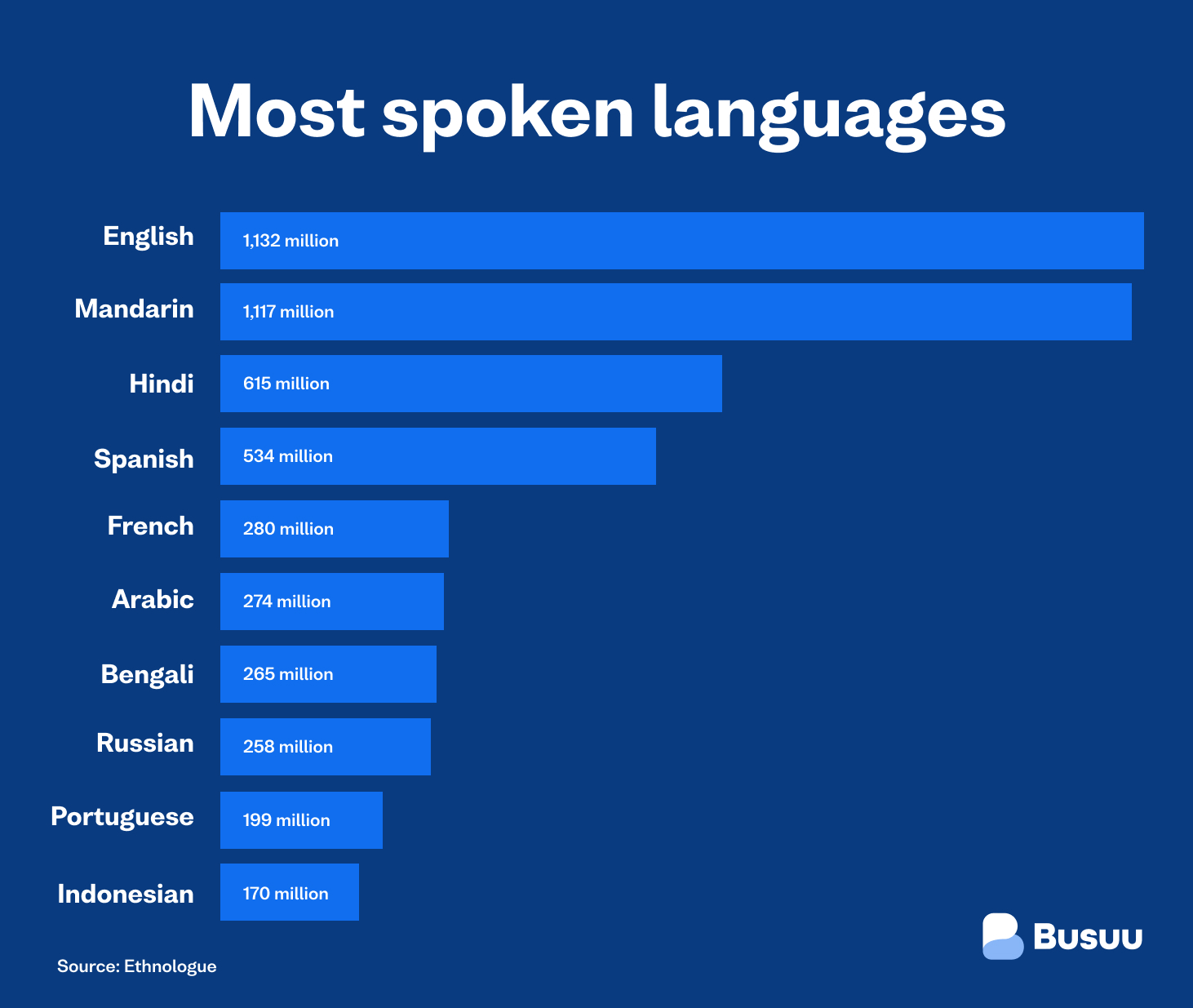
Importance of Multilingual Content & How to Use it to Boost CX
- Language Facts
- Why is Multilingual Content Important?
- How to Develop and Build a Multilingual Marketing Strategy
- Five Steps to a Great Multilingual Strategy
- 1: Have a Clear Core Message
- 2: Create Easily Adaptable Content
- 3: Translation Does not Mean Localization
- 4: Translating
- 5: Integrate your new strategy
- The Takeaway
Hello. Bonjour. Hola. Nin hao. Asalaam Alaikum. Guten tag. Konnichiwa… There are almost eight billion people in the world today, and, between them, they speak more than 7,000 languages. While many of them may be spoken by small numbers of people (for example, there are several endangered languages with very few speakers), most are widely spoken.
Languages present you with a dilemma. You know that communication lies at the heart of your interactions with customers, so how do you incorporate different languages into that communication and enhance your customers’ experience? It seems natural for businesses based in countries where English is the native language to use English, but what about everyone else?
Business today is often aimed at a global marketplace, so despite English being a second language for almost 1 billion people, there are going to be times you have to consider integrating other languages into your marketing communications. How important is this? And how do you decide what languages to integrate?
Language Facts
Before you consider what languages you should be looking at, it’s worth noting the most-spoken languages around the world. English now dominates with around 1.1 billion speakers (some estimates say 1.5 billion). English is so widespread thanks, in part, to the internet, with 25.9% of internet users choosing English. The other main languages used online include:
- Chinese: 19.4%
- Spanish: 7.9%
- Arabic: 5.2%
- Indonesian/Malaysian: 4.3%
Of course, you’re not going to make any decisions based purely on those numbers. Where your focus should lie is on the markets that you operate in. There’s little point in offering Indonesian/Malaysian language options if you operate only in the US. If you’re going to consider multilingual options, then there are two main criteria to consider:
- What countries you operate in
- The languages spoken in those countries
As an example, let’s assume that you only operate in the US. Easy, right? You only need to offer an English language option. Or do you? You have to consider that with a population of more than 334 million, there are going to be many people who either speak little or no English or whose ESL skills are still basic. In fact, the five most used languages in the US are:
- English: 239 million plus
- Spanish: 41 million plus
- Chinese: 3.5 million plus
- Tagalog: Approx 1.7 million
- Vietnamese: 1.5 million plus
Why is Multilingual Content Important?
As you can see from the stats, English is very much the dominant language, both globally and on the internet. But look back at the internet statistic: 25.9% of internet users use English. What that means, in reality, is that if you ignore other languages, you’re ignoring 74.1% of your potential customers (if you’re targeting global markets).
Now, there’s no suggestion that you should be running off and getting all your content translated into multiple languages. This is just another type of demographic targeting. You likely already have marketing that is aimed at customers in a particular geographical area or who are in a particular age group. Multilingual content is basically no different from that.
The main purpose of your content, beyond driving site traffic, sales, and conversions, is to build a relationship of trust with existing and potential customers. How can you build that trust if you’re not communicating with those people in their preferred language? You also need to think about whether products are appropriate for all countries. For example, something like a multi line business phone system could be sold anywhere.
In fact, not only do some 76% of people buying online prefer to purchase from a site that offers content in their native language, 40% of people will never buy from a site that is in a language other than their native one.
If you and your online content are stubbornly English-centric, that’s a lot of potential customers you’re immediately alienating. Recognizing that you need to provide some content in languages other than English is the first step to welcoming those potential customers and providing a better customer experience.
We’ve established that people prefer to read websites, blog posts, emails, etc., in their native languages. We’ve established that they prefer to shop in their own languages, too. The other advantage you can gain is that by using multilingual content, you will have a competitive advantage over those businesses that are still stuck using only English.
How to Develop and Build a Multilingual Marketing Strategy
Once you see the advantages of presenting multilingual content, the question, “How do we develop a multilingual strategy?” will arise. The first thing to note is that this is not just about translating your content. You need to think about localizing it, too, especially if you’re targeting markets in other countries.
In reality, that means being aware of far more than differences in languages. For example, if you were targeting a country such as Indonesia, which is a Muslim country, then you need to be aware of cultural nuances and local customs and laws. So you would need to be careful of things such as images that may offend as well as ensure your textual content is appropriate, too.
As with other aspects of your marketing, the first rule is to do your research. Look at what the local customs and laws are and how those may affect what you’re presenting. You should also look at what channels other than websites that country may prefer to use. The other thing that needs careful research is SEO. What may be a popular search term in English for SaaS SEO growth may not work in any new market.
Look at what already exists in that market and what works in terms of SERPs. Google is not always the preferred search engine in every country, so again, think local and see what works there. As an example, some countries may use different terms when searching for automated call center services, so look at what works in each location.
Five Steps to a Great Multilingual Strategy
1: Have a Clear Core Message
While you want to be aware of cultural and linguistic nuances, you equally want to present your brand clearly no matter the market you’re operating in. Develop a core message that communicates what your brand is about and what your values are. Ensure it’s something that translates well into different languages so that you can use it in any market.
This universal appeal should also be reflected in your branding and logo. Having a bikini-clad beauty as your logo is going to restrict your reach. Global brands, such as Google and Starbucks, have clearly identifiable logos that are instantly recognizable and inoffensive.
2: Create Easily Adaptable Content
You may not have the budget of the global giants who can afford to create localized content in multiple languages. That means you should consider creating content that can easily be adapted to different languages and markets. Of course, you may have to have slightly different content for different regions. However, that still decreases the amount of completely original content you have to produce.
Localization is the key focus here. If you’re operating globally, then you may well have strategies that recognize the differences between Europe and Southeast Asia, for example. All you’re doing now is extending that localization to include multilingual content, too. Again, try to maintain your brand message and values, no matter what language you’re using.
3: Translation Does not Mean Localization
Think about the personalization aspect you probably already use in your marketing. That’s basically what you want to achieve when localizing content. Presenting content in the customer’s language is one thing. Localizing it makes it seem like you’re speaking directly to the customer.
Once again, this entails detailed research into how language is used in that country as well as other elements such as images, colors, icons, etc. A good multilingual strategy is always about more than the language used. Just as your original website considers more than the written content, your multilingual marketing should be the same.
4: Translating
You may be tempted to cut corners when it comes to translating your existing content or creating new content. The problem with cutting corners is that most translation software is nowhere near 100% accurate. It may be fine for translating simple words and phrases, but when it comes to more nuanced language, errors could end up being more costly.
Yet equally, if you’re planning a global multilingual strategy, you don’t want to hire teams of translators as that will quickly eat into your budget. You could do any new strategy one step at a time, prioritizing markets and gradually building content. Perhaps the best solution is that if you need translation work done, look for reliable translation providers.
5: Integrate your new strategy
Once you’ve established your multilingual content, the next step is to integrate it into your existing marketing channels or create new ones when local markets dictate that. In some instances, it will be straightforward to integrate new content. For example, if you have a US website, you may simply choose to add a Spanish language option.
However, if you’re targeting new countries, you may either have to incorporate several language options to your site or create new websites where there are distinct cultural or religious differences. The advantage of separate websites is that some marketing campaigns or special offers will not work in every country.
The Takeaway
Including multilingual content in your marketing strategy is crucial in the modern era and can play a major role in any planned digital transformation. Recognizing the language needs of your target demographics can help provide a better customer experience and can drive increases in sales and revenue.
Article authored by Grace Lau.
Related posts
What is Localization? All you Need to Know
What is Continuous Localization?









